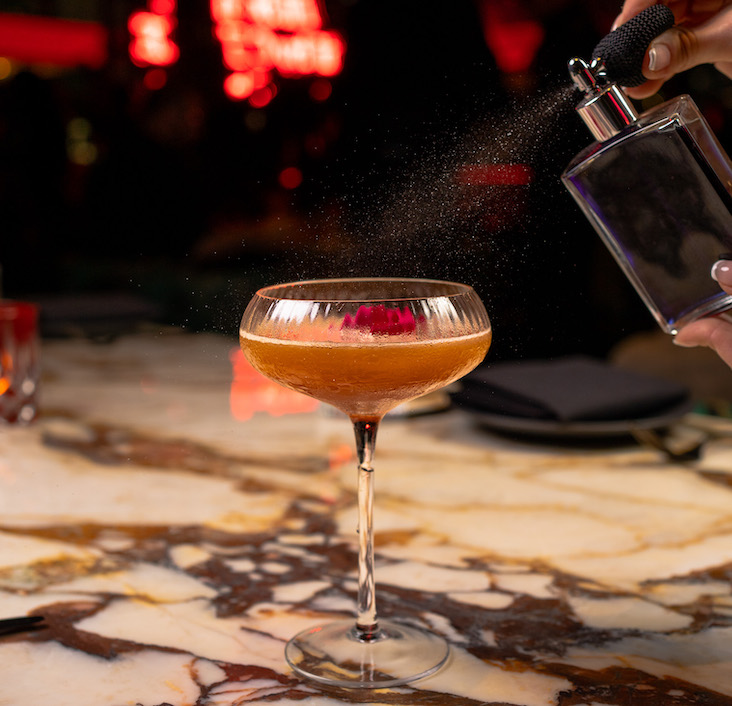The Champagne Mojito at Flute in New York City is presented in a footed iced tea glass.
You’ve heard of the three R’s, but when it comes to stemware, operators are looking for the three S’s-size, shape and strength-and all for the right price. It’s tough to balance beauty and brawn.
“I love the idea of varietal-specific wine glasses,” say Dennis Tafuri, owner and sommelier of Cask 591 in Long Branch, N.J. “But I see it a lot in crystal, not glass. Crystal at $20 to $50 a stem is not practical for our concept,” he adds, explaining that he keeps his markup on wine pretty low. “Frankly, stocking too many different glasses wouldn’t be practical either.”
Tafuri, like many operators, opts for just a few sizes and shapes to cover the wine spectrum. In his case, it’s an Arcoroc 22-ounce red and 16-ounce white for wine by the bottle, one 12-ounce for reds and whites by the glass. “I go big on by-the-glass and bigger and more expensive on by-the-bottle glasses,” he says. “By-the-glass customers are savvy enough to know we’re not shorting them. And when people buy by the bottle, those big glasses are just contagious—everyone wants wine.”
The 12-ounce glass is tempered and can go behind the bar; not so the 16- and 22-ounce glasses. “I just purchased specially-designed lugs (dishmachine racks) to fit the larger glasses,” says Tafuri. “The lugs were expensive, but it’s an investment to reduce breakage.” He also stores the by-the-bottle glasses in a special cabinet in a single layer.
RACK ‘EM UP
Like Tafuri, Herve Rousseau of Flute, in New York City, knows the value of racks. “I learned it the hard way,” he says. When the Champagne bar originally opened, the stock was all high-end Riedel. “It’s beautiful glassware, but we had the wrong size racks and the dishwasher was breaking the stems.” Now, for Champagnes under $100 a bottle, Rousseau opts for flutes from Luminarc, which are washed in tall, properly sized racks. For bottles over $100, he uses Riedel Ouverture flutes, which are washed by hand. Reds and whites are both served in Bermioli 10-ounce Burgunders, which are rack washed.
At Cask 591 in Long Branch, N.J., each style and size of stemware in use has a specific intent.
“When you get a higher quality stemware, breakage definitely becomes an issue; it’s not a commodity item,” says Joshua Haugh, executive assistant manager, food and beverage at the Hyatt Regency, Bethesda, Md. “But the more durable glasses just don’t convey the same elegance.”
Kent Kelso of P.F. Chang’s China Bistro agrees. When the Scottsdale, Ariz., chain switched wine glasses two years ago, it went through a real handling learning curve. “We went from using a kind of clunky 12.5-ounce glass we’d used forever to a more upscale 16-ounce Cabernet from Cardinal for both reds and whites,” says Kelso, director of purchasing, non-food. “The old glass could take a beating, but it had no finesse. The new glass is beautiful, a good size, reasonably durable and well priced, but we had to make operational changes to handle the new stock.”
Changes included replacing three-compartment sinks equipped with spindle brushes with singlerack dishwashers and retraining employees on how to handle the glasses. “We had to teach them how to polish. They were used to polishing the old glasses vigorously, but the stems will snap if you twist the foot and bowl.” The rule now: Move the cloth, not the glass, and go easy.
“You’ve got to invest in proper glass washing racks,” says Hyatt’s Haugh. “They need to fit the glass snugly and fit with the right kind of glass washer. I don’t like conveyor-style washers for stemware,” he explains. “Those flaps can catch stems. I stick to door styles.” When purchasing glassware, Haugh adds that he never buys from catalogs. “I need a sample in my hand and I put it through its paces, knock it over, run it through the machine—I like to have a real feel for its durability, weight and looks.”
Haugh’s stemware pet peeves include cheap glasses with rims that chip easily. With any glassware, a chip is almost worse than a full break because the glass can inadvertently be served to a guest.
Keeping stemware accessible is a challenge for which few have a good solution. “I hate overhead glass hanging racks,” says Haugh. “Glasses gather dust and fill with smoke.” Instead, he “stagger stacks” glasses (the glass above bridging two below) under the bar or on the back bar, with glasses upside down on clean bar mats. Ideally, Haugh and others would just keep glasses in their dish racks, but display’s the thing.
GETTING CREATIVE
Libbey’s Aficionado line
uses a process that
produces a sheer rim and lighter-weight glass.
Today’s operators are also being innovative with glassware. Haugh likes the new stemless wine glasses, but not for regular wine service (for that, he uses a 16-ounce Arcoroc Cabernet for red and 12-ounce for white). “The stemless glasses are perfect for flights,” he says. Hyatt restaurants will do flights by varietal—three Cabs from three countries—or three wines from one producer or region, for example. “The stemless glasses are smaller and easy to maneuver, they won’t knock over, and because you’re pouring smaller amounts into them, you don’t need to worry as much about hand warmth affecting the wine character.” He uses a stemless Riedel Martini glass in a bowl of crushed ice for cold appetizers.
While he dislikes balloon shapes for wine—”you can’t get a good swirl”—Tafuri keeps a few on hand for oversized specialty cocktails. “It beats using a fish bowl,” he laughs. And while he understands that all the romance of the Martini is in the glass, he can’t stand the fact that they spill so easily. “Now I used a fully tempered 10-ounce Martini, which I chill and serve garnished, but empty. On the side, I give the customer a mini shaker that contains the cocktail and they or the server pour it at the bar or table.”
A footed iced tea glass, Iris by Artland Crystal, is the perfect glass for Rousseau’s signature Champagne Mojito at Flute, which he pairs with a special green straw. “It’s important to have a couple of novelty stem glasses,” says Haugh. “But I would try to come up with several drinks that could be served in them to get the biggest bang for the buck.”
Jenna Winthrop specializes in writing about restaurants and foodservice equipment from Chicago.




